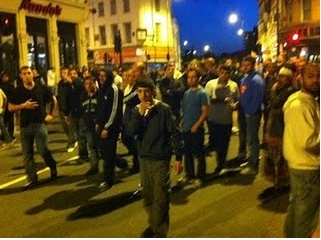 The mobilization of thousands of extra police into London appears to have been successful in preventing further rioting in disorder. However, Nima Khorrami Assl argues that keeping such vast numbers of police on the ground is not sustainable for much longer, especially in light of the government’s intended cuts to police. The government should give serious thought into co-opting those already defending their local communities into voluntary neighbourhood corps under the direct supervision of the police.
The mobilization of thousands of extra police into London appears to have been successful in preventing further rioting in disorder. However, Nima Khorrami Assl argues that keeping such vast numbers of police on the ground is not sustainable for much longer, especially in light of the government’s intended cuts to police. The government should give serious thought into co-opting those already defending their local communities into voluntary neighbourhood corps under the direct supervision of the police.
We have had four nights of nationwide riots and chaos. They have not only caused major embarrassment for the British government and the public, but also, and even more importantly, shed some light on some of the major societal ills in contemporary Britain. The cleanup process has now begun in earnest, and preparations are also being made in case there will be more skirmishes, with Prime Minster David Cameron back from his holiday. Parliament has been recalled, and all police leave cancelled until further notice. In short, these are extraordinary moments and many are asking what triggered them.
One piece of good news that has come out of these events is that for the most part the riots were not fuelled by racial tension, except in Birmingham which is an entirely different case due to the city’s protracted history of racial divisions between the black and Asian communities. Nonetheless, Britain is bitterly divided on the reasons behind the riots with some blaming the unrest on opportunistic criminality and the reviving gang culture at one end of the spectrum, while others blaming the government and its spending cuts.
However, and regardless of what one thinks about the underlying causes of the recent unrest, there should be no doubt that there is a growing sense of disenchantment amongst the working class, in particular the youngsters, and that politics and protest are set to get uglier in the coming years. This, coupled with the shocking images of people looting shops, the upcoming Olympic games, and the very real threat of terrorist attacks, makes it all the more important to pose the difficult question of whether or not Britain has the right policing strategy.
To increase the number of officers to 16,000 is undoubtedly a sound short term strategy which has almost certainly helped to calm the situation in capital. Although a large number of these officers have been drawn from constabularies outside of London and thus are neither familiar with the capital nor have adequate experience in dealing with riot situations, force reinforcement should nonetheless help to quell the riots. The key here is the effect created by David Cameron announcing the increased police presence, which sent a clear message to the public that there is a political will to calm the situation.
But the smart question to be asked now is how sustainable this strategy is? In other words, for how long can we realistically hope to maintain this number of officers patrolling streets of London when the coalition government, according to the chairman of the Conservative Party Baroness Warsi, is intent to carry on with its plan to cut the police funding by 20%.

To be sure, the need for a heavy presence of police forces on our streets is going to remain for some time to come – not only because there is a risk of more riotting, but also because communities around the country have begun defending themselves, leading some commentators to talk about the emergence of ‘good gangs’ and ‘bad gangs’. The real danger here is that ‘bad gangs’ can easily integrate into ‘good gangs’ making it difficult for the police to maintain law and order on streets. There is also the danger of possible clashes between these two forces which could paralyze communities around the country.
Given that the police do not have the resources to maintain a large number of officers on patrol, the government should give serious consideration to the idea of turning these so called ‘good gangs’ into voluntary neighborhood officers/corps (similar to the discussion on police reserve forces on this blog yesterday) under the direct supervision of the police. This would be a cost effective strategy that allows that government to reduce the police budget, while making a very important step towards the realization of its big society ideal. As for the police, this could help to establish better, more constructive ties between the police and local communities.
Please read our comments policy before posting.




